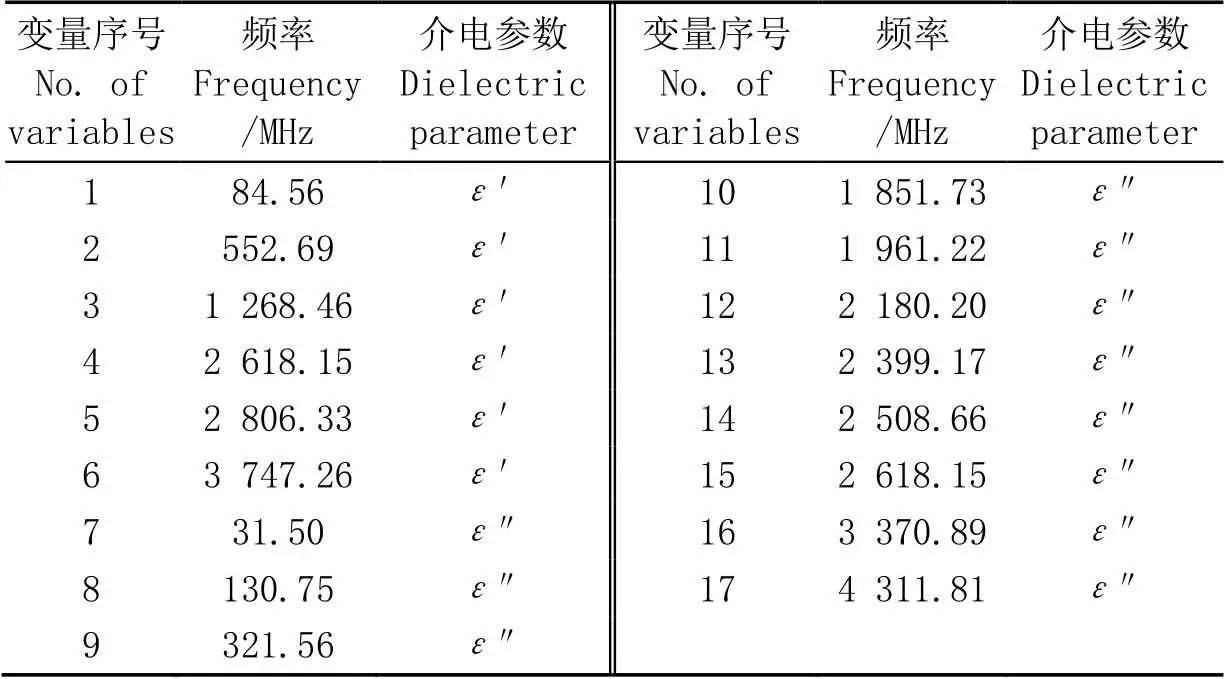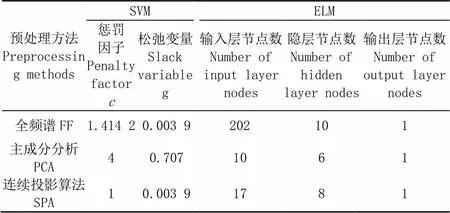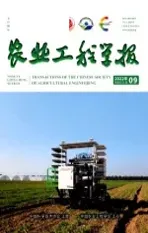基于介电频谱技术的甜瓜品种无损检测
2017-06-27王转卫赵春江孔繁荣翁小凤
王转卫,赵春江,商 亮,孔繁荣,翁小凤
基于介电频谱技术的甜瓜品种无损检测
王转卫1,赵春江2※,商 亮1,孔繁荣1,翁小凤1
(1. 西北农林科技大学机械与电子工程学院,杨凌 712100; 2. 国家农业信息化工程技术研究中心,北京 100097)
研究应用介电频谱技术实现对甜瓜的无损、快速及准确分类。以陕西杨凌某4家大棚外形相似的“红阎良”、“新早蜜”、“208”及“玛瑙”等4类成熟甜瓜为研究对象,采用矢量网络分析仪测量共246个样品在20 MHz~4 500 MHz的介电频谱。用Kennard-Stone 方法划分校正集与验证集,分别建立支持向量机(support vector machine,SVM)和极限学习机(extreme learning machine,ELM)种类判别模型,并比较全频谱(full frequencies,FF)、连续投影算法(successive projection algorithm,SPA)和主成分分析(principal component analysis,PCA)等不同预处理方法对模型精度的影响。结果表明:1)所建6个判别模型验证集总正确率均大于96%,均可用于甜瓜种类的判别。2)对比3种预处理方法,FF完好地保留了样品的原始信息,2种判别模型的验证集总正确率都达到了100%,但由于存在干扰信息导致模型稳定性不好;PCA方法选择能代表原谱信息99.99%的前10个主成分信息用来建模,能有效简化模型,但验证集每个模型均有误判,两种判别模型总正确率分别为96.72%及98.36%;SPA从202个变量中提取17个特征变量参与建模,验证模型整体稳定性较其他两种好,总正确率分别达到96.72%和100%。3)综合考虑判别模型的验证集总正确率及模型稳定性,SPA-ELM模型判别效果最好,验证集总正确率达到100%,更适用于基于介电频谱的甜瓜种类判别。因此,基于甜瓜的介电频谱,通过支持向量机和极限学习机方法可以成功区分甜瓜种类,为甜瓜的无损检测及分类研究提供了一种新方法。
介电特性;支持向量机;模型;甜瓜;极限学习机;分类
0 引 言
甜瓜()是葫芦科中品种最丰富的物种之一,包含许多的变异类型,果实性状与品质变化比较大。根据胡建斌等[1]对于中国甜瓜种质资源形态性状遗传多样性分析,中国不同地区甜瓜种质类型及果实性状差异明显。实际上同一地区、不同品种之间品质上也会存在明显差异。甜瓜作为陕西省的一大特色水果,品种较多,品质各有不同,因此分类研究对于甜瓜的种植、培育及指导消费者选购都有重要意义。
目前国内外对于甜瓜的研究多集中在甜瓜病毒和甜瓜含糖量等领域,如 Nagata等[2]对黄化病毒的研究,Verzera等[3]对甜瓜果实甜度的快速定量测定,Dull等[4-7]利用光谱手段研究甜瓜糖度,姚永波[8]利用LCR测试仪无损检测甜瓜的糖度,而对于甜瓜的分类研究较少。文献显示Stepansky等[9]曾采用计算机视觉技术研究甜瓜的分类方法,但这种方法效率较低,而且主要是从外观来实现分类,而实际中外观相似的甜瓜品质差异也可能会很大。因此,利用现代检测技术,结合甜瓜内部品质对其进行分类研究很有必要。由于农产品的生理变化会反映在其介电参数上,所以通过检测介电参数可以用来判断农产品的品质变化情况。基于终端开路同轴探头技术的介电频谱检测方法被广泛应用于测量液体或含湿量比较高的半固体材料的介电特性[10],因此可用于对甜瓜种类的识别检测。
国外早在20世纪70年代就已经开始利用水果介电特性对其品质进行快速测试,目前美国、欧洲等发达国家在这方面的研究已非常深入。如Soltani等[11]研究了香蕉的介电特性,并成功预测了香蕉的成熟度。国内学者基于介电特性在果品的无损检测及分类方面也有一些研究[12-15],郭文川等[16]将介电特性应用于番茄、苹果等的品种识别研究,对番茄的品种识别率达到了81%,对红富士和红星苹果的识别率达到了91%。谷静思[17]利用介电特性结合人工神经网络能准确识别桃和油桃的品种。
随着人工神经网络技术的发展,误差反向传播网络、径向基网络、支持向量机、极限学习机等机器学习模型以其学习能力强,预测精度高,建模效果稳定等优点被广泛应用于谱数据的分析中[18-20]。本研究以成熟甜瓜为研究对象,采集20~4 500 MHz频率间甜瓜的介电频谱,结合支持向量机及极限学习机建模方法,研究甜瓜种类判别问题,以期为甜瓜的品质无损检测与分类研究提供参考。
1 材料与方法
1.1 试验样品
本研究用试验样品于试验前1 d分别采摘自陕西杨凌某4家农户大棚瓜地,品种分别为种植量较大的“红阎良”、“新早蜜”、“208”及“玛瑙”。采摘时综合考虑阳面、阴面及是否贴地等对果实品质的影响。中熟型厚皮甜瓜开花后一般35 d左右即可上市,本研究用试验样品是开花后40 d的成熟甜瓜。4类样品(分别简称为v1,v2,v3及v4)数量分别为91,80,41和34个,样品总数246个。所有样品外形相似(类球形)、大小相近(500 g左右)、无损伤且表皮颜色均匀。采摘后的样品存放在室温(24±2)℃实验室,测试前将样品擦净晾干并编号。
1.2 仪器及数据处理软件
E5071C型矢量网络分析仪、85070E末端开路同轴探头及85070C软件(Agilent Technologies,马来西亚),Matlab(R2011a,Math Works,马萨诸塞州,美国),Unscrambler v10.2(CAMO,奥斯陆,挪威)等。
1.3 测试步骤
图1所示为甜瓜介电特性测量系统示意图。首先预热E5071C型矢量网络分析仪,然后按步骤校准仪器并设定测量范围[21]。校准完成即可测量甜瓜样品的介电特性。本研究是在甜瓜样品赤道位置附近相隔大约90°均匀选取4个测量点,将样品横放在小型支架上,提升支架使样品测量点表皮与垂直向下的探头紧密接触,顺序测量4个测点的介电频谱数据,以4点处的平均值作为该甜瓜样品的最终测量结果。
本研究中,每个甜瓜样品的总变量数为202个,其中'(相对介电常数)对应的101个值为该样品的前101个变量,''(介质损耗因数)对应的101个值为该样品的后101个变量。
1.4 数据分析及处理方法
1.4.1 样品集划分方法
本研究采用经典的Kennard-Stone(KS)方法进行样品集的划分。该方法基于样品介电谱差异选择转换集样品的划分方法,划分结果是将介电谱差异较大的样品选入校正集,将其余相近样品归入验证集,保证代表性强的样品全部划入校正集,进而最大程度地使校正集样品分布均匀。KS 方法被普遍应用在谱数据的定性分析领域[22-23]。
1.4.2 介电谱预处理方法
本研究中预处理方法选择主成分分析(principal component analysis, PCA)和连续投影算法(successive projection algorithm, SPA),并与不做预处理的全频谱(full frequencies,FF)信息下的判别模型做对比研究。PCA是一种面向模式分类的数据降维方法,是在保证尽可能多地反映原始信息的基础上,用较少的一些主成分代替原来较多的分析元素,从而达到简化模型的目的,目前已被广泛应用到谱数据压缩、图像处理等领域。SPA是一种前向循环的变量选择方法,能降低模型复杂度,有效消除各变量间的线性相关影响,使优选变量更具有代表性[24-26]。
1.4.3 建模方法
本研究选取两种建模方法,分别为支持向量机(support vector machine, SVM)和极限学习机(extreme learning machine, ELM)。SVM作为一种非线性网络校正方法,可以有效提高建模效率,较好解决小样本、非线性问题。ELM方法具有学习速度快、泛化性能好等特点,在模式识别和非线性拟合等方面具有明显优势[27-31]。
2 结果与分析
2.1 甜瓜的介电特性
图2所示为4种甜瓜在不同频率下的介电特性变化曲线,可以看出所有甜瓜样品的介电参数随频率变化规律类似。其中,相对介电常数' 均随频率增大而减小(见图2a),且在低频段减小迅速,在200 MHz以后减小明显缓慢;介质损耗因数'' 随频率的增大先减小,而在1 000 MHz以后稍有增大(图2b)。另外,从图2中可以看出,不同品种甜瓜间介电参数存在种类差异,特别是在低频段,大部分品种间差异明显,因此,基于甜瓜介电特性可以对其进行分类研究。但图2a显示,v1、v3的' 曲线重叠较严重;图2b显示,高频段所有甜瓜的''曲线重叠较严重,所以仅通过介电参数频率曲线难以实现种类的完全识别,还需借助合适的数学分析方法来解决,本研究在介电谱数据基础上,通过合理的样本划分,并结合不同的数据预处理方法及建模方法来提高总体识别率。
2.2 校正集与验证集的划分
样品集的有效合理划分对于模型的建立至关重要,也将直接影响模型的适用性与预测精度。如果可以在样品集中选取具有代表性的样品作为校正集,则会使模型的预测效果及稳定性大幅提升。为此,本研究基于Matlab软件平台,根据4类数量分别为91,80,41和34的甜瓜样品原始介电频谱,采用KS方法将样品按照大约3:1的比例划分为校正集与验证集。划分结果见表1。
2.3 PCA预处理
应用Matlab 2011a中的princomp()函数对样品的原始介电谱进行主成分分析,所得前10个主成分的累积贡献率见表2。从表2中可以看出:前6个主成分的累积贡献率已达到99.926%,即前6个主成分所携带的信息量已反映了原始频谱99.9%以上的信息,但若选取过少的主成分可能会丢失少部分有效信息,影响最终建模效果。因此,为保证更少损失原始介电谱的有效信息,并使数据处理效率较高且模型运算相对简单,本研究选取累积贡献率达到99.99%以上的前10个主成分用于后续种类识别模型的建立。

表1 Kennard-Stone样品集划分结果

表2 前10个主成分的累积贡献率
2.4 SPA预处理
应用SPA对甜瓜介电频谱进行特征频率选取。SPA方法提取的特征频率数目取决于校正集的交叉验证均方根误差(root mean square error,RMSE)值,RMSE随特征变量数的增加而不断减小,以其不再显著减小时的变量数作为最佳特征变量数。本研究中设定特征频率数范围为3~30,RMSE变化曲线如图3所示,当频率个数大于17时,RMSE不再显著减小,据此优选出17个特征频率变量。所选特征频率及对应的介电参数见表3。

表3 SPA选取的17个特征频率
2.5 支持向量机及极限学习机训练参数选择
选取逼近速度快,效率高的径向基核函数用于支持向量机建模[32]。用十折交叉验证方法确定SVM的惩罚因子()和松弛变量()。首先将参数、的范围设为2×10-8~2×108,利用网格搜索法进一步确定精细范围为2×10-4~2×104,最终确定和的取值。本研究中ELM网络的激活函数选定sig函数,隐层节点数根据多次重复试验确定。初始权值随机确定,一般可以通过增加重复建模次数来提高模型的稳定性[33]。
经全频谱(full frequencies,FF)、PCA与SPA预处理后分别建立的SVM、ELM种类判别模型的各参数选取结果见表4。

表4 SVM及ELM模型参数
2.6 甜瓜种类识别效果比较分析
通过KS法划分校正集与验证集,在FF、PCA和SPA预处理后,应用SVM及ELM方法分别设计甜瓜种类判别模型,对品种1~4(v1~v4)的判别结果如表5所示。结果显示,6种判别模型的验证集总正确率最小为96.72%,最大达到100%,总正确率大于96%,说明这6种模型均可用于此4种甜瓜的种类判别。其中对v2的判别正确率最高,没有误判,这与图2中v2品种介电参数相对较大的结果相一致;其他3种均有不同数目的误判现象。由于验证集介电参数范围相对比较集中,导致大部分模型校正集误判数大于验证集误判数。在后续研究中,可以进一步验证并完善模型。

表5 SVM和ELM的甜瓜种类判别结果
从表5中可看出,在6种判别模型中,FF-SVM,FF-ELM及SPA-ELM 3种模型的总验证正确率均达到100%,其中SPA-ELM校正模型最稳定,只对一个品种有误判,说明此模型更适合用于甜瓜种类的判别。
对比3种不同预处理方法,FF完好地保留了样品的全部信息,验证总正确率最高,但因为存在噪声干扰、数据重叠等问题,导致模型整体稳定性不是最好;PCA方法从原始数据中筛选出前10个主要成分信息作为输入变量,能有效简化模型,但每个模型对验证集都有误判,所以总正确率不高;SPA方法从原始数据中提取出17个主要特征变量参与建模,验证结果整体比较稳定,总正确率较高。对比SVM和ELM 2种建模方法,都是将问题被动映射到高维空间做分类,但SVM核函数决定了唯一的映射方式,而ELM映射方式很多,且ELM的训练速度更快,所以ELM模型整体效果更好。
3 结 论
本研究基于介电频谱无损检测技术,对“红阎良”、“新早蜜”、“208”及“玛瑙”等4种成熟甜瓜样品分别建立了支持向量机(support vector machine, SVM)和极限学习机(extreme learning machine, ELM)2种分类判别模型,并分别比较了全频谱(full frequencies,FF)、主成分分析(principal component analysis, PCA)和连续投影算法(successive projection algorithm, SPA)等3种不同数据预处理方法对简化模型、提高模型准确度及稳定性的影响。结论如下:
1)所建模型验证集总正确率均大于96%,表明基于介电频谱技术对成熟甜瓜进行无损分类研究方法可行。由于不同种类甜瓜即使外形相似,也会存在内部品质方面的差异,体现在糖度、含水率、硬度等指标的不同,而这些品质指标的差异又反映在不同频率点处的介电参数不同上,即介电谱有差异。所以基于介电谱数据可以实现对不同种类甜瓜的无损、准确识别。
2)对比全频谱FF、PCA降维及SPA提取特征变量等3种方法所建模型,结果表明均可用于甜瓜分类研究的数据预处理。其中,FF方法总验证正确率达到100%,但模型较复杂;PCA方法总验证正确率分别达到96.72%和98.36%,总正确率不是最高;SPA方法总验证正确率分别达到96.72%和100%,且校正模型相比较最稳定,更适用于介电频谱的预处理工作。
3)与其他模型相比,SPA-ELM分类效果最好,总验证正确率达到100%,且只对一个品种有误判,说明SPA-ELM模型更适合用于介电频谱下甜瓜的分类研究。
4)将介电频谱无损检测技术与SVM算法、ELM人工神经网络方法相结合,成功地应用于成熟甜瓜的分类研究中,说明介电频谱无损判别甜瓜种类方法可行,分类准确度较高,为甜瓜的无损检测及分类、分级提供了一种新方法,并为介电频谱在果品内部品质检测及分类研究方面的应用提供了新的理论基础。
[1] 胡建斌,马双武,简在海,等. 中国甜瓜种质资源形态性状遗传多样性分析[J]. 植物遗传资源学报,2013,14(4):612-619.
Hu Jianbin, Ma Shuangwu, Jian Zaihai, et al. Analysis of genetic diversity of Chinese melon (L.) germplasm resources based on morphological characters[J]. Journal of Plant Genetic resources, 2013, 14(4): 612-219. (in Chinese with English abstract)
[2] Nagata T, Dutra L S, Oliveira P A, et al. Analysis of the triple gene block sequence in an important melon pathogen, melon yellowing-associated virus[J]. Journal of General Plant Pathology, 2010, 76(4): 268-272.
[3] Verzera A, Dima G, Tripodi G, et al. Fast quantitative determination of aroma volatile constituents in melon fruits by headspace-dolid-phase microextraction and gas chromatography-mass spectrometry[J]. Food Analytical Methods, 2011, 4(2): 141-149.
[4] Dull G G, Birth G S, Smittle D A, et al. Near infrared analysis of soluble solids in intact cantaloupe[J]. Journal of Food Science, 2006, 54(2): 393-395.
[5] Dull G G, Birth G S, Leffler R G. Exiting energy distribution in honeydew melon irradiated with a near infrared beam[J]. Journal of Food Quality, 1989, 12(12): 377-381.
[6] Dull G G, Leffler R G, Birth G S. Near-infrared spectrophotometry for measurement of soluble solids in intact honeydew melons[J]. Hortscience A Publication of the American Society for Horticultural Science, 1990, 25(9): 1132-1136.
[7] Dull G G, Leffler R G, Birth G S, et al. Instrument for nondestructive measurement of soluble solids in honeydew melons[J]. Transaction of the ASAE, 1990, 35(2): 735-737.
[8] 姚永波. 基于介电特性的甜瓜糖度无损检测[D]. 乌鲁木齐: 新疆大学,2012.
Yao Yongbo. Nondestructive Inspection of Melon's Sugar Content Based on Dielectric Properties[D]. Urumchi: Xinjiang University, 2012. (in Chinese with English abstract)
[9] Stepansky A, Kovalski I, Perl-Treves R. Intraspecific classification of melons (Cucumis melo L.) in view of their phenotypic and molecular variation[J]. Plant Systematics and Evolution, 1999, 217(3): 313-332.
[10] 郭文川,朱新华. 国外农产品及食品介电特性测量技术及应用[J]. 农业工程学报,2009,25(2):308-312.
Guo Wenchuan, Zhu Xinhua. Foreign dielectric property measurement techniques and their applications in agricultural products and food materials[J]. Transactions of the Chinese Society of Agricultural Engineering (Transactions of the CSAE), 2009, 25(2): 308-312. (in Chinese with English abstract)
[11] Soltani M, Alimardani R, Omid M. Evaluating banana ripening status from measuring dielectric properties[J]. Journal of Food Engineering, 2011, 105(4): 625-631.
[12] 胥芳,计时鸣,张立彬,等. 水果电特性的无损检测在水果分选中的应用[J]. 农业机械学报,2002,33(2):53-56.
Xu Fang, Ji Shiming, Zhang Libin, et al. Nondestructive inspection of dielectric property of fruit and its application in classifying fruit quality[J]. Transactions of the Chinese Society for Agricultural Machinery, 2002, 33(2): 53-56. (in Chinese with English abstract)
[13] 陈克克. 水果介电特性及其与品质关系的研究[D]. 杨凌:西北农林科技大学,2009.
Chen Keke. Study on Dielectric Properties of Fruits and Their Relationships With Qualities[D]. Yangling:Northwest A&F University, 2009. (in Chinese with English abstract)
[14] 刘文超,廖宇兰,崔万春,等. 基于介电特性的水果无损检测技术的应用分析[J]. 食品研究与开发,2011,32(6):90-93.
Liu Wenchao, Liao Yulan, Cui Wanchun, et al. The applicated analysis of nondestructive determination in fruit based on dielectric properties[J]. Food Research and Development, 2011, 32(6): 90-93. (in Chinese with English abstract)
[15] 黄良妹,李晓龙,马惠玲. 红富士果实内部品质的电学法无损检测[J]. 食品研究与开发,2013,12(5):74-79.
Huang Liangmei, Li Xiaolong, Ma Huiling. Non-destructive detection with electric basis on internal qualities of Fuji apple fruit[J]. Food research and development, 2013, 12(5): 74-79. (in Chinese with English abstract)
[16] 郭文川,郭康权,朱新华. 介电特性在番茄和苹果品种识别中的应用[J]. 农业机械学报,2006,37(8):130-132.
Guo Wenchuan, Guo Kangquan, Zhu Xinhua. Application of dielectric properties in identifying species of tomatoes and apples[J]. Transactions of the Chinese Society for Agricultural Machinery, 2006, 37(8): 130-132. (in Chinese with English abstract)
[17] 谷静思. 基于介电频谱/近红外光谱技术检测采后桃和油桃的品质及品种[D]. 杨凌:西北农林科技大学,2014.
Gu Jingsi. Identifying Qualities and Varieties of Postharvest Peaches and Nectarines by Using Dielectric Spectra/ Near-Infrared Spectra Technology[D]. Yangling:Northwest A&F University, 2014. (in Chinese with English abstract)
[18] Yao Y, Wang C, Liu H, et al. Biomass compositional analysis using sparse partial least squares regression and near infrared spectrum technique[J]. Spectroscopy and Spectral Analysis, 2015, 35(7): 1864-1869.
[19] Zhao M, Downey G, O’Donnell C P. Exploration of microwave dielectric and near infrared spectroscopy with multivariate data analysis for fat content determination in ground beef[J]. Food Control, 2016, 3(10): 3414-3418.
[20] Hertrampf A, Sousa R M, Menezes J C, et al. Semi-quantitative prediction of a multiple API solid dosage form with a combination of vibrational spectroscopy methods[J]. Journal of Pharmaceutical and Biomedical Analysis, 2016, 124(5): 246-253.
[21] 郭文川,商亮,王铭海,等. 基于介电频谱的采后苹果可溶性固形物含量无损检测[J]. 农业机械学报,2013,44(9):132-137.
Guo Wenchuan, Shang Liang, Wang Minghai, et al. Soluble solids content detection of postharvest apples based on frequency spectrum of dielectric parameters[J]. Transactions of the Chinese Society for Agricultural Machinery, 2013, 44(9): 132-137. (in Chinesewith English abstract)
[22] 王铭海. 猕猴桃、桃和梨品质特性的近红外光谱无损检测模型优化研究[D]. 杨凌:西北农林科技大学,2013.
Wang Minghai. Study on Optimal Model for Nondestructive Detection of Kiwifruit, Peach and Pear Quality Characteristic by NIR Spectroscopy[D]. Yangling: Northwest A&F University, 2013, (in Chinese with English abstract)
[23] 刘伟,赵众,袁洪福,等. 光谱多元分析校正集和验证集样本分布优选方法研究[J]. 光谱学与光谱分析,2014,34(4):947-951.
Liu Wei, Zhao Zhong, Yuan Hongfu, et al. An optimal selection method of samples of calibration set and validation set for spectral multivariate analysis[J]. Spectroscopy and Spectral Analysis, 2014, 34(4): 947-951. (in Chinese with English abstract)
[24] 刘韬,田洪祥,郭文勇. 主成分分析在某型柴油机光谱数据分析中的应用[J]. 光谱学与光谱分析,2010,30(3):779-782.
Liu Tao, Tian Hongxiang, Guo Wenyong. Application of PCA to diesel engine oil spectrometric analysis[J]. Spectroscopy and Spectral Analysis, 2010, 30(3): 779-782. (in Chinese with English abstract)
[25] 洪涯,洪添胜,代芬,等. 连续投影算法在砂糖橘总酸无损检测中的应用[J]. 农业工程学报,2010,26(增刊2):380-384.
Hong Ya, Hong Tiansheng, Dai Fen, et al. Successive projections algorithm for variable selection in nondestructive measurement of citrus total acidity[J]. Transactions of the Chinese Society of Agricultural Engineering (Transactions of the CSAE), 2010, 26(Supp.2): 380-384. (in Chinese with English abstract)
[26] 郭文川,林碧莹. 牛奶含水率介电谱结合化学计量学检测方法[J]. 农业机械学报,2016,47(9):249-254.
Guo Wenchuan,Lin Biying. Detecting moisture content of cow’s milk using dielectric spectra and chemometrics[J]. Transactions of the Chinese Society for Agricultural Machinery, 2016, 47(9): 249-254. (in Chinesewith English abstract)
[27] 商亮. 基于介电谱无损检测苹果品质及种类[D]. 杨凌:西北农林科技大学,2015.
Shang Liang. Nondestructive Detection of Apples' Quality and Varieties by Dielectric Spectra[D]. Yangling:Northwest A&F University, 2015. (in Chinese with English abstract)
[28] Huang G, Zhu Q, Siew C K. Extreme learning machine: Theory and applications[J]. Neurocomputing, 2006, 70(1/2/3): 489-501.
[29] Huang G, Zhou H, Ding X, et al. Extreme learning machine for regression and multiclass classification[J]. IEEE Transactions on Systems, Man and Cybernetics. Part B, Cybernetics: A Publication of the IEEE Systems, Man and Cybernetics Society, 2012, 42(2): 513-529.
[30] Deng C, Huang G, Xu J, et al. Extreme learning machines: new trends and applications[J]. Science China (Information Sciences), 2015, 58(2): 1-16.
[31] 章鸣嬛,陈瑛,沈瑛,等. 人工神经网络和支持向量机性能比较及其在DMD疾病识别中的应用[J]. 上海理工大学学报,2016,38(4):346-351.
Zhang Minghuan, Chen Ying, Shen Ying, et al. Comparative study on the performances of ANN and SVM and their application in the identification of DMD disease[J]. J. University of Shanghai for Science and Technology, 2016, 38(4): 346-351. (in Chinese with English abstract)
[32] 商亮,谷静思,郭文川. 基于介电特性及ANN的油桃糖度无损检测方法[J]. 农业工程学报,2013,29(17):257-264.
Shang Liang, Gu Jingsi, Guo Wenchuan. Non-destructively detecting sugar content of nectarines based on dielectric properties and ANN[J]. Transactions of the Chinese Society of Agricultural Engineering (Transactions of the CSAE), 2013, 29(17): 257-264. (in Chinese with English abstract)
[33] 孟田源,王转卫,迟茜,等. 基于高光谱成像技术生长发育后期苹果糖度的无损检测[J]. 西北农林科技大学学报:自然科学版,2016, 44(6):228-234.
Meng Tianyuan, Wang Zhuanwei, Chi Qian, et al. Non-destructive prediction of soluble solids content in apples at late development period based on hyperspectral imaging[J]. Journal of Northwest A&F University: Natural Science Edition, 2016, 44(6): 228-234. (in Chinese with English abstract)
Nondestructive testing of muskmelons varieties based on dielectric spectrum technology
Wang Zhuanwei1, Zhao Chunjiang2※, Shang Liang1, Kong Fanrong1, Weng Xiaofeng1
(1.,,712100,;2.,100097,)
To classify muskmelons quickly and accurately based on dielectric spectroscopy, dielectric properties of 4 kinds of melons (a total of 246) were measured with network analyzer over the frequency range from 20 to 4 500 MHz. The samples were selected from 4 different greenhouses in Yangling, Shaanxi Province, which had similar shape and size, and had no injury and disease. All samples were divided into calibration set and validation set with a ratio of about 3:1 based on Kennard-Stone method. Methods of support vector machine (SVM) and extreme learning machine (ELM) were applied to establish discriminative models of muskmelons. We chose 2 different variable selecting methods as pre-processing methods before modeling. One method was principal component analysis (PCA) for data dimension reduction, and the other was successive projections algorithm (SPA) for characteristic variables selecting. The model validating effects after the processing of PCA and SPA were used to compare with that with no pre-processing; besides, directly modeling with full frequencies (FF) spectra data was also adopted. The results were shown as below: 1) All discriminative models under FF, PCA and SPA methods could be used for classifying muskmelons. The total correct rate of each validation set reached over 96%, and the ELM modeling method was better than SVM method as a whole. 2) The models based on the FF method retained all original information of the frequency spectra data, so it had the highest validation correct rate, up to 100%. But its stability and reliability were not good enough because of the existing interference information. Under the PCA method, the accumulating contribution rate of the former 10 principal components extracted from all variables approached to 99.99%, which well reflected original information while simplifying the model in some degree and improved performance of models, however, the results were not very stable and the total correct rate of 2 models was much lower than others, up to 96.72% and 98.36% respectively. Seventeen characteristic variables were selected by the SPA from all 202 variables for modeling, which not only simplified the model and improved its performance, but also had the higher accuracy. Therefore, the SPA method was more suitable for the variables selecting based on dielectric spectrum. 3) In all models, SPA-ELM had the minimum misjudgments and the highest total correct rate, which was more suitable for classifying muskmelons according to dielectric frequency spectra. Therefore, it’s feasible to classify muskmelons based on dielectric spectrum by the modeling methods of SVM and ELM. It also shows that the dielectric spectrum technology can be used to do more research on muskmelon classification and grading, and provides the new theory and methods for future research about nondestructive detection of muskmelons.
dielectric properties; support vector machine; models; muskmelon; extreme learning machine; classification
10.11975/j.issn.1002-6819.2017.09.038
O657
A
1002-6819(2017)-09-0290-06
2016-12-19
2017-01-17
国家科技支撑计划(2015BAD19B03)和陕西省农业科技攻关项目(2016NY170)联合资助
王转卫,女,陕西富平人,讲师,主要从事农产品无损检测技术与应用研究。杨凌西北农林科技大学机械与电子工程学院,712100。Email:wzw630@126.com
赵春江,男,研究员,博士,主要从事农业信息技术与精准农业技术体系研究。北京国家农业信息化工程技术研究中心,100097。Email:zhaocj@nercita.org.cn
王转卫,赵春江,商 亮,孔繁荣,翁小凤. 基于介电频谱技术的甜瓜品种无损检测[J]. 农业工程学报,2017,33(9):290-295. doi:10.11975/j.issn.1002-6819.2017.09.038 http://www.tcsae.org
Wang Zhuanwei, Zhao Chunjiang, Shang Liang, Kong Fanrong, Weng Xiaofeng. Nondestructive testing of muskmelons varieties based on dielectric spectrum technology[J]. Transactions of the Chinese Society of Agricultural Engineering (Transactions of the CSAE), 2017, 33(9): 290-295. (in Chinese with English abstract) doi:10.11975/j.issn.1002-6819.2017.09.038 http://www.tcsae.org
